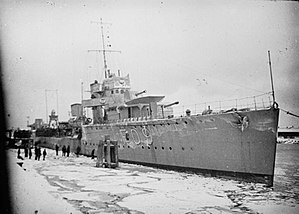HMS Vega (L41)

HMS Vega in port in Russia in 1919.
|
|
| History | |
|---|---|
|
|
|
| Name: | HMS Vega |
| Namesake: | Vega, the brightest star in the constellation Lyra |
| Ordered: | 30 June 1916 |
| Builder: | William Doxford & Sons, Sunderland |
| Laid down: | 11 December 1916 |
| Launched: | 1 September 1917 |
| Completed: | 12 December 1917 |
| Commissioned: | 14 December 1917 |
| Decommissioned: | 1920s/1930s? |
| Identification: |
|
| Recommissioned: | 1939 |
| Decommissioned: | 1945 |
| Identification: | pennant number:L41 |
| Motto: | Praeclare fulgens ("Shining brightly") |
| Honours and awards: |
Battle honour for North Sea 1940–1945 |
| Fate: | Sold for scrapping 4 March 1947 |
| Badge: | A gold lyre with a silver star in chief on it, all on a blue field |
| General characteristics | |
| Class and type: | Admiralty V-class destroyer |
| Displacement: | 1,272–1,339 tons |
| Length: | 300 ft (91.4 m) o/a, 312 ft (95.1 m) p/p |
| Beam: | 26 ft 9 in (8.2 m) |
| Draught: | 9 ft (2.7 m) standard, 11 ft 3 in (3.4 m) deep |
| Propulsion: |
|
| Speed: | 34 kt |
| Range: | 320–370 tons oil, 3,500 nmi at 15 kt, 900 nmi at 32 kt |
| Complement: | 110 |
| Armament: |
|
The second HMS Vega was a V-class destroyer of the British Royal Navy that saw service in World War I and World War II.
Vega was ordered on 30 June 1916 as part of the 9th Order of the 1916–17 Naval Programme. She was laid down on 11 December 1916 by William Doxford & Sons at Sunderland, England, and launched on 1 September 1917. She was completed on 12 December 1917 and commissioned into service on 14 December 1917. Her original pennant number, F4A, was changed to F92 in January 1918 and to F09 in April 1918. It became D52 during the interwar period.
Vega was assigned to the Grand Fleet or Harwich Force and saw service in the last year of World War I, suffering damage while operating with the fleet in 1918.
Vega was among the ships which accompanied the battlecruisers HMS Hood and HMS Tiger during their visit to Scandinavian ports in June 1920. During the voyage, she and the destroyer HMS Vectis (D51) tested the Royal Navy's High Speed Mine Sweep, which the British Admiralty hoped to use in the shallow waters of the Baltic in the event of a war with Bolshevik Russia (soon to become the Soviet Union). In a blow to the Admiralty's plans, both destroyers lost their minesweeping apparatus, demonstrating the High Speed Mine Sweep to be impractical in shallow water.
...
Wikipedia
